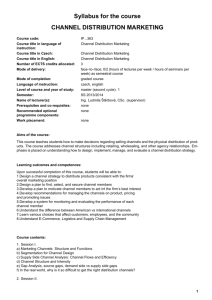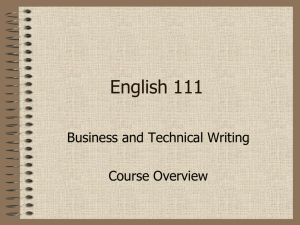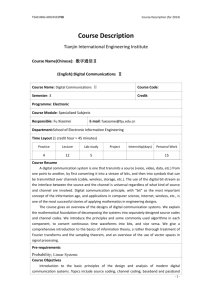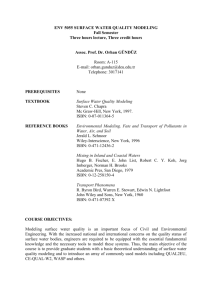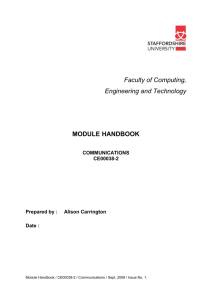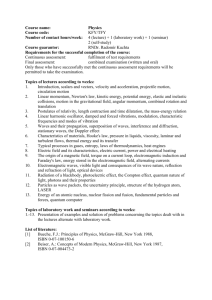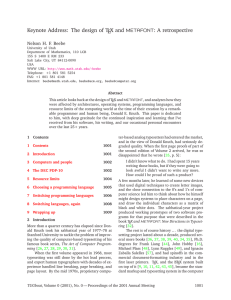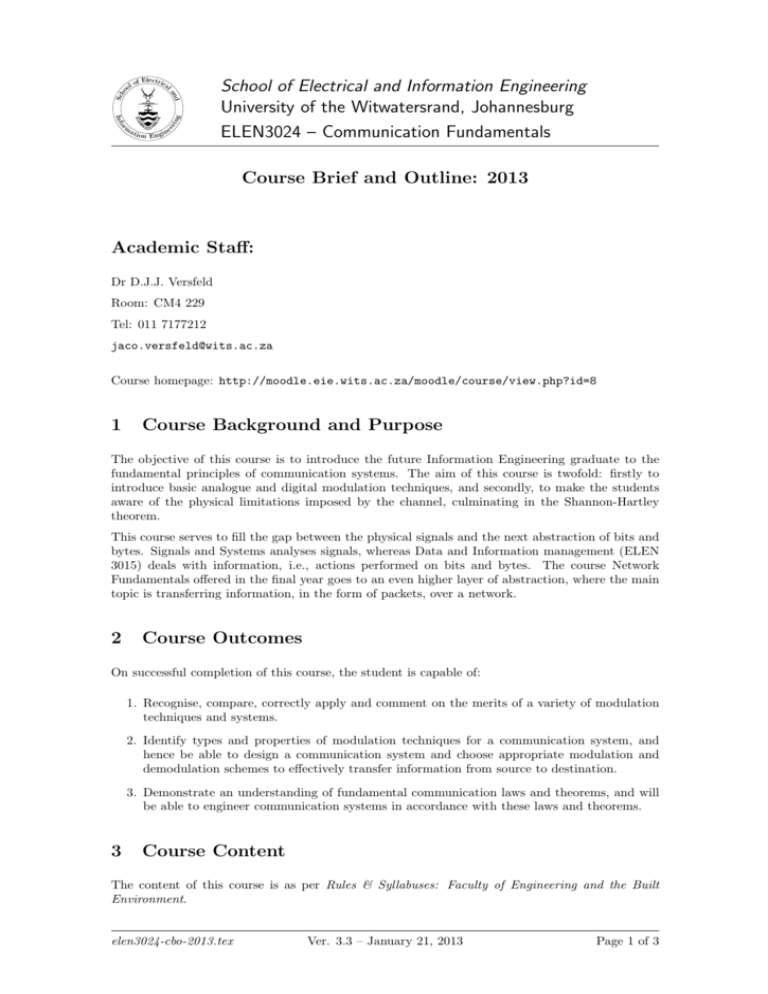
d
an
Sch
o
le
of E ctrica
l
ol
ati
er
or
in g
Inf
m
on E n gin
e
School of Electrical and Information Engineering
University of the Witwatersrand, Johannesburg
ELEN3024 – Communication Fundamentals
Course Brief and Outline: 2013
Academic Staff:
Dr D.J.J. Versfeld
Room: CM4 229
Tel: 011 7177212
jaco.versfeld@wits.ac.za
Course homepage: http://moodle.eie.wits.ac.za/moodle/course/view.php?id=8
1
Course Background and Purpose
The objective of this course is to introduce the future Information Engineering graduate to the
fundamental principles of communication systems. The aim of this course is twofold: firstly to
introduce basic analogue and digital modulation techniques, and secondly, to make the students
aware of the physical limitations imposed by the channel, culminating in the Shannon-Hartley
theorem.
This course serves to fill the gap between the physical signals and the next abstraction of bits and
bytes. Signals and Systems analyses signals, whereas Data and Information management (ELEN
3015) deals with information, i.e., actions performed on bits and bytes. The course Network
Fundamentals offered in the final year goes to an even higher layer of abstraction, where the main
topic is transferring information, in the form of packets, over a network.
2
Course Outcomes
On successful completion of this course, the student is capable of:
1. Recognise, compare, correctly apply and comment on the merits of a variety of modulation
techniques and systems.
2. Identify types and properties of modulation techniques for a communication system, and
hence be able to design a communication system and choose appropriate modulation and
demodulation schemes to effectively transfer information from source to destination.
3. Demonstrate an understanding of fundamental communication laws and theorems, and will
be able to engineer communication systems in accordance with these laws and theorems.
3
Course Content
The content of this course is as per Rules & Syllabuses: Faculty of Engineering and the Built
Environment.
elen3024-cbo-2013.tex
Ver. 3.3 – January 21, 2013
Page 1 of 3
4
Prior Knowledge Assumed
The prerequisites and corequisites for this course are as per Rules & Syllabuses: Faculty of Engineering and the Built Environment.
5
Assessment
All submissions must be in strict accordance with the guidelines contained in the Schools Blue
Book and the rules contained in the Schools Red Book. No exceptions will be considered.
5.1
Components of the Assessment
This is described in the Schools document entitled Application of Rule G.13 and Calculator Requirements on the School notice board.
5.2
Assessment Criteria
All the outcomes are assessed explicitly in the test and examination. All the components of the
assessment (test, laboratory and examination) are mandatory (Satisfactory Performance requirements) and an overall mark of 50% or higher is required to obtain a credit for this course.
5.3
Satisfactory Performance Requirements
Rule G.13 and the Schools documents entitled Application of Rule G.13 and Calculator Requirements and the Schools Red Book (see the School notice board) apply.
5.4
Calculators in examinations
See the Schools document entitled Application of Rule G.13 and Calculator Requirements on the
School notice board.
6
6.1
Teaching and Learning Process
Teaching and Learning Approach
Lectures and tutorials are not mandatory components of this course. However, students are
strongly advised to attend all tutorials and lectures.
6.2
Arrangements
Lectures Lectures will take place in lecture periods 1 and 2 every Tuesday and period 3 every
Wednesday.
Tutorials There is one 1-hour tutorial per week, in the fourth lecture period every Wednesday.
More information on tutorial sessions will be provided in class.
Laboratories Laboratory sessions will take place on Monday and Tuesday afternoons. More
information on laboratory activities will be provided in class.
Consultation A modified open door policy will be followed, eg. you should bring with a written
paper with your attempt of the problem which is to be consulted on.
elen3024-cbo-2013.tex
Ver. 3.3 – January 21, 2013
Page 2 of 3
7
Information to Support the Course
7.1
Prescribed Text/Reading
(This book must be purchased)
1. John G. Proakis and Masoud Salehi, Communication Systems Engineering, 2nd Edition,
Prentice Hall, 2002. ISBN: 0-13-061793-8
7.2
Other References
1. S Haykin, Communication Systems, 5th Edition, Wiley, 2009. ISBN: 0471697907
2. B. P. Lathi, Modern Digital and Analog Communication Systems, 3rd Edition, Oxford University Press, 1998. ISBN: 0-19-511009-9
3. John G. Proakis and Masoud Salehi, Contemporary Communication Systems using MATLAB, Brooks / Cole Thomson Learning, 2000. ISBN: 0-534-37173-6
4. Ferrel G. Stremler, Introduction to Communication Systems, Addison-Wesley, ISBN: 0-20107259-9
5. Gordon E. Carlson, Signal and Linear System Analyses, 2nd Edition, John Wiley & Sons,
1998, ISBN 0-471-12465-6.
7.3
Course Homepage
Further information and announcements regarding the course is posted on the course home page.
All students are expected to consult the course home page at regular intervals.
8
8.1
Other Information
Administrative details
Further information and announcements regarding the course will be communicated either via the
web page, verbal announcements or printed material distributed during lectures. Handouts for
laboratories, tutorials and the project will be issued during the course.
Although a Personal Computer is not a requirement for any Electrical, Information or Biomedical
Engineering course, it is strongly recommended as a useful tool from the second year of study
onwards.
All students are expected to regularly consult the course home page.
c
Copyright
School of Electrical and Information Engineering, All Rights Reserved.
elen3024-cbo-2013.tex
Ver. 3.3 – January 21, 2013
Page 3 of 3

